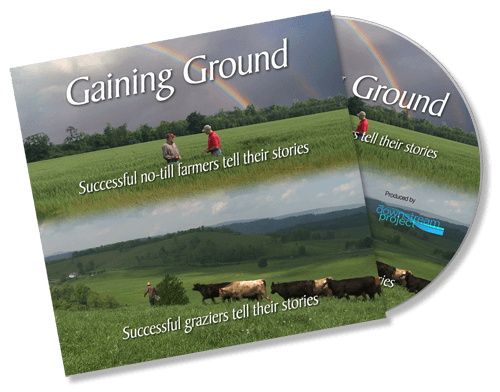After watching the Gaining Ground movies many people want to know what to do next. They are interested and want to adopt some of the management practices discussed in the movies to achieve similar results.
It is important to consider all the resources available to assist you. Start by considering these three areas:
- Farmers/graziers in your local area who have successfully adopted these practices
- Technical support in your local area (NRCS, SWCD, Extension, Chesapeake Bay Foundation field staff)
- Technical publications and fact sheets that provide unbiased, research based information about the different aspects of no-till and/or grazing management that were mentioned in the movies
Graziers in your local area
Local experienced graziers in your community are a very beneficial resource that you should get to know and form some type of relationship with over time. These graziers are often willing to share information and provide you suggestions as you make your transition to a higher level of grazing management if you take the time to ask.
The Virginia Forage and Grassland Council (VFGC) is currently partnering with the Shenandoah Valley Resource Conservation and Development Council to explore different opportunities for graziers to network better with each other both locally and regionally. Results of this initiative will be shared later in 2012.
Technical Support in Your Local Area
As with any farm project it is important to have a clear vision of an achievable goal or outcome before investing a lot of time and money. Developing a well thought out plan and putting it on paper greatly increases your potential success and helps to minimize time and money that is wasted in the process.
Start by visiting your local USDA- NRCS and SWCD office. The staffs at these offices specialize in developing conservation plans for private farm operations. Request a farm visit from your local NRCS and SWCD staff, provide them a farm tour to describe your current operation and describe your goals for the future. Ask the local staff to conduct a pasture condition score and run a forage-livestock balance for your operation. Once this is complete they can meet with you again to review the farm operation summary complete with an up-to-date aerial photo of your farm land, a soil map with productivity ratings for those soils, an outline of your basic goals, a list of existing resource concerns, a benchmark forage-livestock balance, and a list of basic recommendations for improving the productivity and utilization of your forage-livestock system while enhancing soil and water quality in the process.
After reviewing this information if improved grazing management would benefit your farm operation, the local staff can utilize their maps and grazing planning tools to work with you to develop a grazing system plan based on your specific management goals. This involves cross fencing, water system development, paddock design layout, and usually modifying stocking rate to more closely balance the forage produced by your grazing system to meet the needs of the livestock on the farm.
Virginia Cooperative Extension provides outreach and education information on a number of livestock, forage and pasture management topics to include weed and brush control. On nearly every pasture at some point during the year there is weed and brush problems. Your local Cooperative Extension agent is another resource available to provide proper weed identification, help identify the cause of the weed problem and if needed make appropriate herbicide recommendations ( http://pubs.ext.vt.edu/456/456-016/Section_5_Weeds-4.pdf ). Always remember to use an integrated approach to managing pasture weeds to include soil fertility management, grazing management, clipping/moving and spot treatment using selective herbicides as needed and according to the herbicide product label.
Technical Publications and Information
Many very good publications about grazing management and managing the overall forage-livestock system are available to learn more about these topics. A complete list is too extensive to include on this website but some very good publications are listed below for those interested.
When searching sources of information whether it is news print, magazines or online blogs, always be aware and try to distinguish between what is a researched proven fact versus what is observation and general opinion. Keep in mind a particular management strategy that works for a grazier in one region and may not work for a grazier in other regions of the state or country due to variations in soils, forage species adaptability, climate and length of growing season just to name a few.
Below are few titles of publications and websites where you can access these and other publications that will build your library of knowledge on topics related to grazing management and the forage-livestock system.
Virginia Cooperative Extension Publications at:
http://pubs.ext.vt.edu/category/pasture-forage-cs.html
VCE Publication 418-012 “Controlled Grazing of Virginia’s Pastures”
VCE Publication 422-130 “Planning Fencing System For Controlled Grazing”
VCE Publication 418-050 “Making the Most of Tall Fescue in Virginia”
VCE Publication 418-007 “No-till Seeding of Forage Grasses and Legumes”
VCE Publication 424-100 “Agronomy Handbook 2000”
USDA-NRCS Grazing and Pasture Management Publications
http://www.nrcs.usda.gov/wps/portal/nrcs/main/national/landuse/rangepasture/pasture/pub
USDA-NRCS “Managing Grasslands for Profit: A Guide to Grazing Management in the Southeast”
USDA-NRCS “Guide to Pasture Condition Scoring
USDA-NRCS “Pasture Condition Score Sheet
http://soils.usda.gov/sqi/management/gl_mgmt.html
Pastureland Soil Quality – Introduction
Pastureland Soil Quality – Indicators for Assessment and Monitoring
http://www.sunshine-unlimited.com/brochure/
Grass: The stockman’s crop How to harvest more of it, by Harland Dietz.
Forage Publications from the University of Kentucky
http://www.uky.edu/Ag/Forage/ForagePublications.htm
AGR 199 “Extending Grazing and Reducing Stored Feed Needs”
ID 143 “Rotational Grazing”

